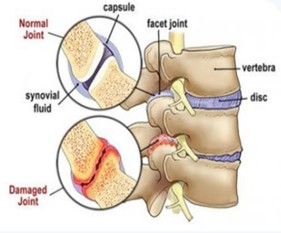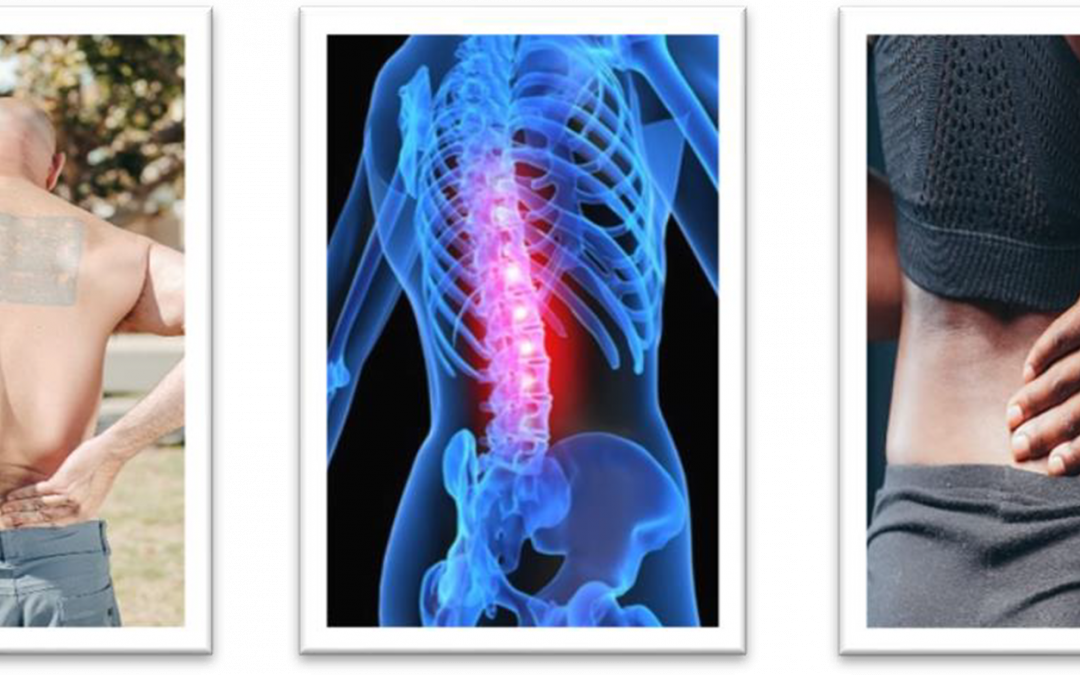As you might imagine, this is a question I am asked on a regular basis. The quick answer is many things can contribute to back pain. However, the fundamental approach is that inflammation and tissue dysfunction are at the root cause.
A number of factors can lead to inflammation and there are several tissue types that can be inflamed. Namely nerves, muscles, ligaments, tendons, joints, bones, discs, fascia, meninges, blood, and lymphatic vessels. Something else to remember is other organs such as the kidneys, bladder, prostate, ovaries, uterus, small and large intestine, and the rectum can all refer pain to the lower back and tailbone area, as well.
We are going to briefly describe some of the more common causes of lower back pain. We will not discuss cancer or other tumors which can lead to back pain in some cases. The focus of this article will be the musculoskeletal, neural, and structural related issues leading to lower back pain. Later in our series on lower back pain, we will go into further depth on some of the topics brought up in this newsletter.
The Sacro-Iliac Syndrome:
This problem is often overlooked and considered relatively unimportant. However, the location, proper function, and alignment of the sacro-iliac (SI) is crucial for the proper function of the hips, lumbar spine, discs and for that matter the entire spine.
All your body weight is distributed through this joint and allows proper shifting of your body as you walk and perform your daily activities. Without proper functioning of this joint, it makes it difficult to recover and often can contribute to other issues in the lower back, groin, and hips. Gentle chiropractic manipulation, coupled with pulsed ultrasound and proper muscle balancing will greatly help to improve the function of the SI joint.

Figure 1: Sacro-iliac Joint
All your body weight is distributed through this joint and allows proper shifting of your body as you walk and perform your daily activities.
Without proper functioning of this joint, it makes it difficult to recover and often can contribute to other issues in the lower back, groin, and hips. Gentle chiropractic manipulation, coupled with pulsed ultrasound and proper muscle balancing will greatly help to improve the function of the SI joint.
Lumbar Disc Syndrome:
Lodged between your vertebral are “cushions,” medically referred to as discs. These discs are made of essentially two parts. A gelatinous inner core that acts like a balancing ball called the nucleus pulposus, as well as, concentric and crisscrossing tough fibers made primarily of collagen, called the annular fibrosis.
When there is a certain degree of inflammation or damage, particularly to the annular fibrosis, this can lead to a herniated disc (often not requiring surgery) which is just a bulged or misshaped disc. This bulged, inflamed disc can affect nerves that are found within the disc and/or the surrounding spinal nerves leading to lower back pain, buttock, or sciatic pain going down the leg.
Usually there are five lumbar discs, and the location of the low back pain depends upon which disc(s) are involved. An upper lumbar disc could lead to pain, numbness in the hip or along the front of the leg. Alternatively, when the lower discs are affected, typically the pain, numbness, and cramping is along the back of the buttock and leg leading to sciatica.
There are gentle chiropractic techniques to help normalize these discal problems. It is important to address the causes of the inflammation in the discs and to rebuild the strength and integrity of the disc by proper nutrition and hydration. Additionally, continual core muscle work and strengthening is vitally important.
Furthermore, poor diet, nutritional deficiencies, and other soft-tissue inflammatory factors affect the important collagen makeup of the discs. Improper alignment overtime also affects the disc integrity. In some cases, the inflammation is so bad that steroid and other anti- inflammatories may be needed.

Figure 2: Normal vs. Herniated Disc
Degenerative Disc Syndrome:
This is where the disc itself begins to lose its integrity, height, flexibility, and ability to maintain proper shape. It is often associated with surrounding degenerative arthritic changes. The alteration of the disc leads to increasing frequency of spinal nerve irritation and/or compression and may lead not only to chronic lower back pain, but increased likelihood of sciatica and complaints in the thigh, knee, calf, and ankles/feet. Some of the other symptoms could be numbness, muscle spasms, muscle cramping, burning and weakness in the legs.
Gentle chiropractic techniques along with gentle discal decompression approaches are beneficial for relieving symptoms related to degenerative disc syndrome. Simultaneously, it is important to decrease inflammation, address the integrity of the disc nutritionally and work on core muscle function. Integrating low level/cold laser and acupuncture can be of great relief and reduce inflammation, as well.

Figure 3: Degenerative Disc
Lumbar Facet Syndrome:
Along the back of the lumbar vertebra are joints called facets joints. These facets can become misaligned and create pain, muscle spasms, and restricted painful movement. These joints can
“overlap” one another and create a situation called imbrication, which often requires distraction and gentle manipulation. Some individuals have some facet surfaces that are shaped differently between the left and right side of an individual vertebra called asymmetrical facets. Over time these joints can also demonstrate degenerative changes and bone spurring.

Figure 4: Imbrication in the Vertebrae
Lumbar Stenosis:
This is a condition in which the inner canal of lumbar vertebra is reduced in shape and diameter. Some people genetically have smaller canals than others. However, most of the time this is brought on by a combination of degenerative disc, degenerative/arthritic facets and thickening of spinal ligaments. This condition can cause chronic back and leg pain, muscle cramping, muscle weakness and in more severe cases can cause loss of bladder or bowel control. Stenosis can affect the spinal cord, spinal membrane (meninges) and spinal nerves.

Figure 5: Healthy Spine vs. Spinal Stenosis
Gentle chiropractic treatments can help with stenosis, but it is also important to reduce inflammation in the canal and in the surrounding nerves and tissues. This can be accomplished with low level laser, natural anti-inflammatories, and eliminating foods that cause inflammation. It is generally better to utilize less invasive approaches as mentioned or injections of steroids and/or anti-inflammatories before surgery is considered.
Osteoporosis/Osteopenia:
This is a condition in which the vertebral structures especially the vertebral bodies, pelvic and hip bones not only become thin or less dense, but more importantly, lose their strength! This usually occurs more frequently in older post-menopausal women.
Pain associated with osteoporosis often occurs after there are compression fractures of the vertebral body or fractures of the hips and pelvis. This pain can come on suddenly and can be severe. Prior to the fracture there may be no pain or just mild pain when weight bearing.
Osteopenia/osteoporosis is usually a condition that has developed over many years. To counter this it is important to have proper digestion so there is adequate protein, mineral, and other nutrient absorption.
Additionally, proper adrenal and hormonal balance is critical.
Furthermore, weight bearing exercises are a must. Most importantly and often ignored is to decrease inflammation that can affect the bone cells involved in bone metabolism regulation. More on this in a previous newsletter archived on our website here.
Piriformis Syndrome:
The piriformis muscle is a small, strong muscle that is located towards the lower buttock. It is responsible for rotation of the hip and is important in both maintaining proper posture and gait. Sometimes the muscle will spasm or become inflamed resulting in lower buttock/hip pain and/or sciatica. Fascial release, gentle chiropractic treatment, electrical stimulation or ultrasound may be needed to alleviate this condition.
Lower Back Sprain/Strain:
Most people are familiar with lower back sprain and strain. It can occur from excessive physical activity, injury, poor posture, improper muscle function and muscular coordination/balance. Keep in mind that many of these lower back problems can have underlying soft-tissue inflammation (muscles, tendons, ligaments, fascia, discs) and weakness, which often predisposes someone to lower back pain.
These early signs of back problems if not properly addressed can potentially lead to some of the other conditions listed previously. A proper physical, orthopedic, chiropractic, and biochemical evaluation often helps to understand some of the root causes of the sprain/strain especially if it is reoccurring and/or chronic. Additionally, proper X-ray and/or MRI imaging can also be extremely helpful in evaluating this condition and deciding on proper treatment.
Poor Foot and Ankle Function/Alignment:
If you notice your back pain more while standing, walking, or after activities such as running, basketball, soccer, tennis, and pickle ball, your problems may be coming from your feet and ankles! The ankles and feet are the foundation of posture and influence the alignment of the entire body.
There are also very important nerve endings located in your tendons, fascia, muscle, ligaments and joints in your ankle and foot. These nerve endings transmit important neural information to your postural muscles throughout your body and helps coordinate muscular motion. Interestingly, abnormal alignment in the ankle and feet can affect your acupuncture meridians, as well!
Emotional/Stressful Back Pain:
The limbic system is an area of the brain responsible for the behavioral and emotional response and it provides input to other parts of the brain, nervous, and hormonal system. Our brain and nervous system can directly influence muscular tone and blood flow. Moreover, continued release of stress hormones can result in weakened connective tissue such as tendons, ligaments, and discs.
Therefore, our emotional state can have a significant influence on the appearance or continuation of lower back pain. Feelings of anxiety, depression, and hopelessness are often associated with lower back pain.
Various stress reduction techniques, behavioral modification, floral essences, cannabidiol (CBD), different herbal supplements, and acupuncture can be of great help in resolving some of these back issues. Proper vitamin, mineral, hormonal, and antioxidant levels can also have a profound effect on mental/emotional states and pain perception.
Soft-tissue Inflammation:
There are many things that lead to low grade inflammation of the bones, blood vessels, discs, fascia, muscles, nerves, tendons, and cartilage that can increase lower back pain. Just as an example, imbalances between omega 6 fats versus omega 3 fats can result in an individual being more prone to inflammation. Likewise, consumption of glutens can cause musculoskeletal inflammation, as well.
Furthermore, keep in mind that low grade inflammation prevents proper healing of tissue and can cause additional damage and degeneration to the tissues involved. Therefore, performing food sensitivity tests, stool, proper blood, and salivary hormone analysis can be crucial to finding some of these underlying causes of low-grade inflammation. For more information regarding testing, you can reference some of our prior articles and videos here. We will have additional content on the topic of low-grade inflammation in the future.
Summary:
We have covered some of the more common reasons for lower back pain and the list is of course not complete. We will explore these different types of back conditions individually in more detail in future newsletters.
It is best to have the proper examination, imaging, testing, and chiropractic analysis to help identify some of the causes of your lower back problems. If you are suffering from acute or chronic lower back pain, please give us a call at: (480) 732-0911.
Best of Health,
James D. Reade DC, CFMP
Image References
Figure 3:
McCance, M. (2015, September 29). The Impact of Nutrient Transport on Disc Degeneration and Low Back Pain. McCance MD. https://mccancemd.com/the-impact-of-nutrient-transport-on-disc-degeneration-and-low-back-pain/

